The Iraq Scheme is a programme funded by the UK government, through the Department of Culture, Media and Sport, directed by Jonathan Tubb (keeper of the ME department), and delivered through the British Museum, with the aim of building capacity in the State Board of Antiquities and Heritage by training Iraqi archaeologists in cultural heritage management and practical fieldwork skills. The training is intended to provide participants with the expertise and skills they need to face the challenges of documenting and stabilising severely disrupted and damaged heritage sites in preparation for potential reconstruction. The training consists of two months based in London at the British Museum followed by two months hands-on training on site in Iraq. This practical training takes place at the two field projects of the Iraq Scheme, in the south of Iraq at the site of Tello, and in the north at the Darband-i Rania in the Kurdish Region of Iraq.

Tello, the modern Arabic name for the ancient Sumerian city of Girsu, is one of the earliest known cities of the world together with Uruk, Eridu and Ur. In the 3rd millennium BC Girsu was considered the sanctuary of the Sumerian heroic god. It was the sacred metropolis and centre of a city-state that lay in the south-easternmost part of the Mesopotamian alluvium. Pioneering explorations carried out between 1877 and 1933 and the decipherment of the cuneiform tablets discovered there revealed to the world the existence of the Sumerians who invented writing 5,000 years ago and may have developed a primitive form of democracy or polyarchy well before the ancient Greeks.

Like the recently liberated Assyrian capitals of northern Mesopotamia, Nimrud or Nineveh, Girsu is a mega-site extensively excavated in the nineteenth and early twentieth centuries, with a similar topographical layout shaped by huge excavation pits and spoil heaps. It includes fragile remains of monumental architecture excavated before World War II such as the Bridge of Girsu – the oldest bridge as yet brought to light, which is the focus of site conservation. Tello is therefore a site of the first order, ideal for delivering the training for the Iraqi archaeologists in the context of a fully-fledged research programme.
The story of the renewed field-work at Tello-Girsu, after some eighty years of interruption, is a palimpsest of archaeological layers spanning five thousand years which reflects superimposed or overlapping destinies of gods, demons, and men.
The central protagonist is the mighty god Ningirsu, the tutelary deity of the city who battled fiercely with the demons of the primordial Mountain where both the Tigris and Euphrates originate, and, thus, made possible the introduction of irrigation and agriculture in Sumer. Ningirsu was the god of the thundershowers and floods, and was envisaged originally as the thundercloud. The demigod or demon Imdugud (Anzû), the thunderbird, perceived as a giant lion-headed eagle, was Ningirsu’s avatar or hypostasis, and the emblem of the city.
Other dominant figures of the excavations include the sovereign Gudea who ruled Girsu four-thousand years ago and who, throughout his reign, never ceased to pride himself in his abundant commemorative inscriptions for his zeal in religious behaviour and of having undertaken and completed the construction or renovation of magnificent temples to serve as abodes to the pantheon of Girsu. Adad-nadin-aḫḫe was an enigmatic Babylonian potentate, perhaps the lord of a fiefdom of the fading Seleucid Empire. He built a palace two thousand years after Gudea on the ruined sacred city of Girsu and, truly fascinated by the past, perpetuated the old Sumerian rituals of burying foundation deposits, stamping bricks with his name, in both Aramaic and Greek, and, also, collected Gudea’s statues as holy antiques and embodiments of ancestral kings. Ernest de Sarzec was the last archaeologist-consul of Mesopotamia. Two-thousand years after Adad-nadin-aḫḫe, he resurrected Girsu and its gods only thanks to his fierce desire and determination paying for it with his life.
That Tello/Girsu has a strong connection with the British Museum is proven by the abundant artefacts on display, including a truly unique statue of the ruler Gudea.
Although the god Ningirsu is not represented herein, at least in his anthropomorphic form, the Sumerian galleries are nevertheless charged with his overwhelming divine aura. Many votive artefacts, foundation tablets, and copper figurines of gods were indeed dedicated to the tutelary deity of Girsu. The god appears en majesté in his pre-human form of the tempestbird on the Ninḫursag temple relief from Ubaid, and a votive mace head from Tello, both depicting the lion-headed eagle grasping stags or lions, i.e., mastering the Mesopotamian wilderness. The British Museum also holds the very first rediscovered statue personifying the charismatic ruler Gudea found by William Loftus in 1850 at the site of Tell Hammam which also represents the first Sumerian sculpture to have reached Europe together with the reliefs of the genii accompanying the winged bulls from Khorsabad.

Excavations in the autumn of 2016 and spring of 2017 at Tello were carried out in the heart of the sacred district of Girsu, at Tell A, also-known as the Mound of the Palace. They led to the discovery of extensive mudbrick walls – some ornamented with pilasters and inscribed cones – belonging to the Ningirsu temple constructed and several times renovated by Sumerian rulers, including Ur-Bau and Gudea. This temple called Eninnu: The-White-Thunderbird dedicated to the heroic god was considered in antiquity as one of the most important sacred places of Mesopotamia, praised for its splendour in many contemporary literary compositions. The search for the Eninnu has mesmerized generations of Assyriologists. Known until now only by cuneiform texts and a plan carved on a statue of a worshipping Gudea, its discovery represents a significant milestone in the history of renewed archaeological research in Iraq.
Of this four-thousand-year-old religious complex, were exposed during the first two seasons what appeared to be the central part of the sanctuary: a decorated entrance featuring buttresses, a peripheral ambulatory with in situ cones, the cella composed of an offering altar facing the podium for the divine cult statue, and passageways marked by colossal inscribed stones.
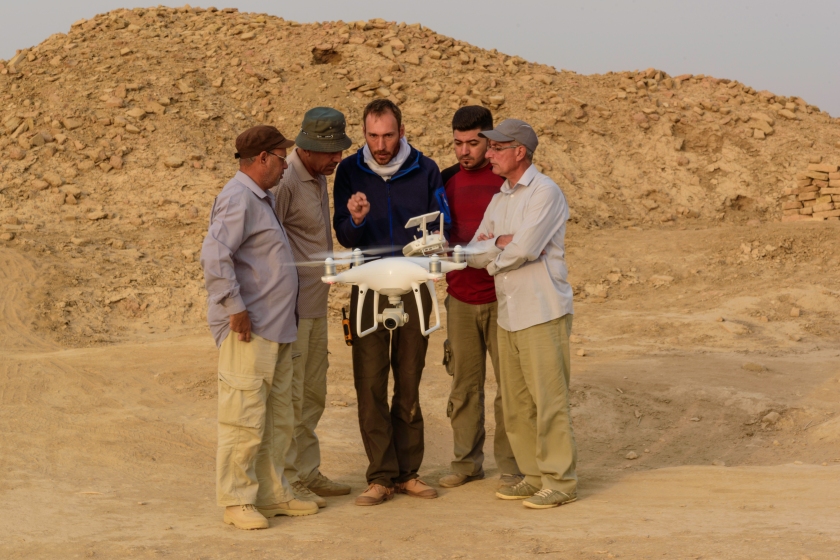
The results of the last autumn 2017 season were extremely successful. In the Mound of the Palace, we continued to excavate the monumental sacred complex belonging to the god Ningirsu. The main highlights were the discovery of the South gate flanked by two towers and the temenos wall which included a foundation box.
The box was unusually big, 9 courses high, with a large Gudea brick as the cover with the inscription face down. Under the cover, a well-preserved impression of a reed mat in bitumen. The box unfortunately had been opened in antiquity and the copper foundation figurine removed. But, at the bottom of the box, we found the stone tablet still in situ. A white square tablet with the inscription in two columns. The tablet was oriented towards the cella and the podium for the divine cult statue. It was buried in a deposit of pure sand and was placed on a small reed mat. Samples of bitumen and soils from the ritual box have been brought back to the British Museum to be analysed.
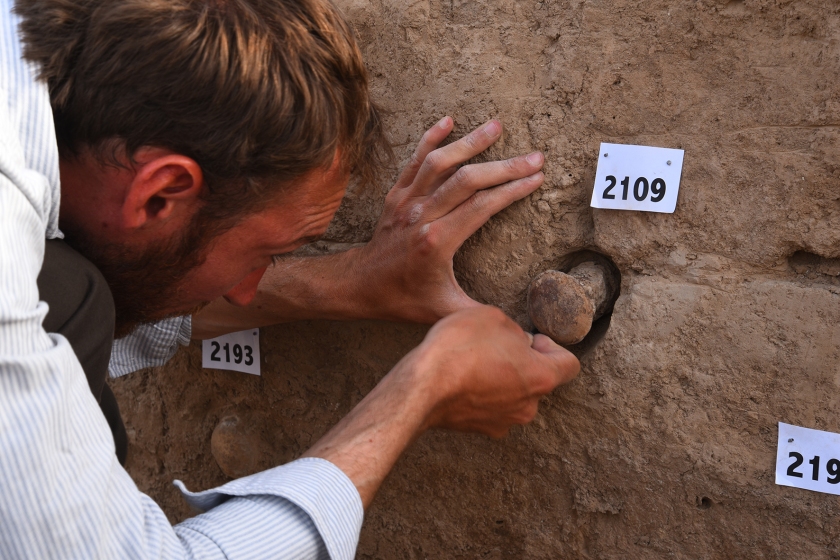
More than fifteen inscribed cones were found in situ in the walls of the temple. The recording of the exact location of each cone reveals that they were laid in a complex pattern; we are currently analysing this pattern to establish whether it encodes information of magical/religious significance.
Excavations under the temple also led to the discovery of two superimposed monumental platforms, the oldest of which, made of red mudbricks and built in two steps, may be dated to the beginning of the third millennium BC. This is an important discovery since this proto-ziggurat, a precursor to the legendary Tower of Babel, would therefore predate the earliest-known Mesopotamian stepped-terrace by a few hundred years.
Four new soundings were opened in Tell L, situated at the edge of the ancient city in the vicinity of the city wall. They also yielded important results. We have uncovered mudbrick walls, and another foundation box made of fired bricks, unfortunately empty. We have reasons to believe, however, on the basis of inscribed cones in secondary context and others scattered on the surface, that this mound (Tell L) and the one adjacent to it (Tell M) formed a large complex, perhaps a temple gate dedicated to the goddesses Inanna and Nanshe. This new excavation was closely connected to the extensive survey that was carried out in the western residential area, between the Sacred city and Tell L, which yielded important new information on the domestic quarters of the city of Girsu.
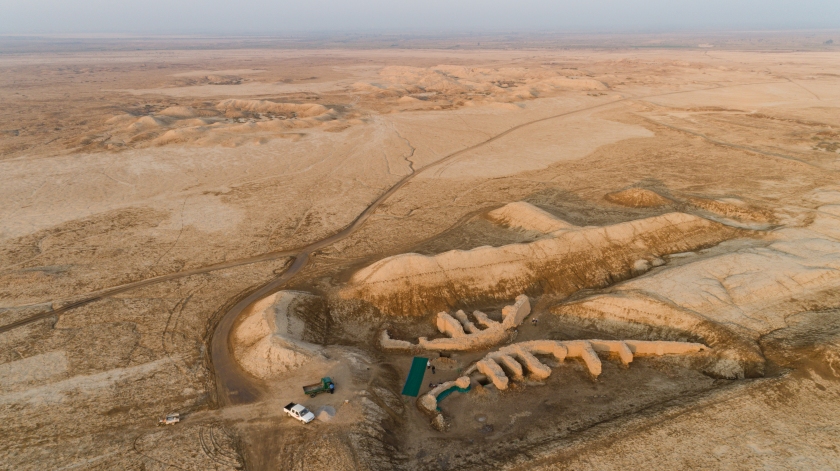
New conservation work was initiated on the Bridge of Girsu, discovered and excavated at the end of the 1920s and early 1930s. The preliminary condition assessment of this unique monument of Sumerian architecture, left exposed for 80 years, stressed the urgency of carrying out a larger and more ambitious conservation programme, including preventive excavations.
Since excavation, the site has remained open and exposed, with no identifiable conservation work to address long-term stability or issues of erosion, and no plans to manage the site, or engage with a local or wider audiences.
The objectives of the 2017 autumn season at the bridge site were therefore to understand the structure, record its condition and to test conservation options, as the first steps towards developing a comprehensive conservation plan, with the Iraqi archaeologists involved at every stage.
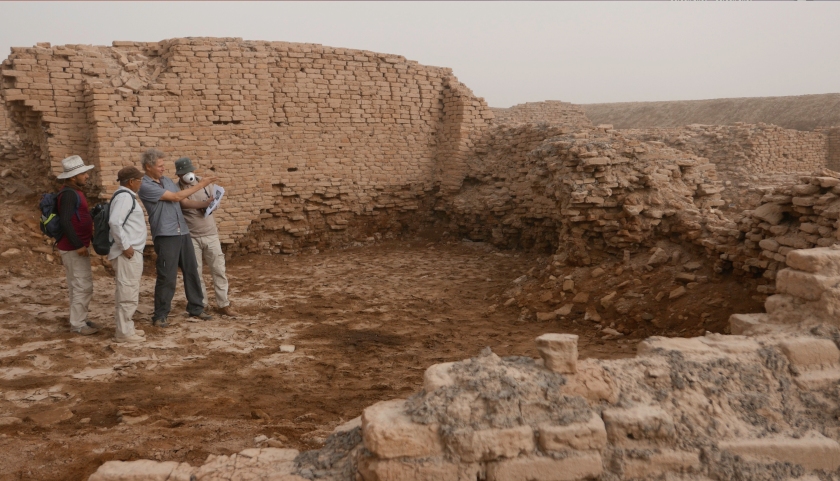
Excavations to establish the condition and stability of this construction led to the discovery of exceptionally well-preserved deposits of the prehistoric Ubaid period, including painted pottery and uninscribed cones, which yield a wealth of information on the origins of Girsu and consequently the birth of urban centres in Mesopotamia.
All the important finds from these excavations have already been safely delivered to the Iraq Museum in Baghdad, while a column base from the Ningirsu temple will be displayed in the nearby museum of Nasiriya.
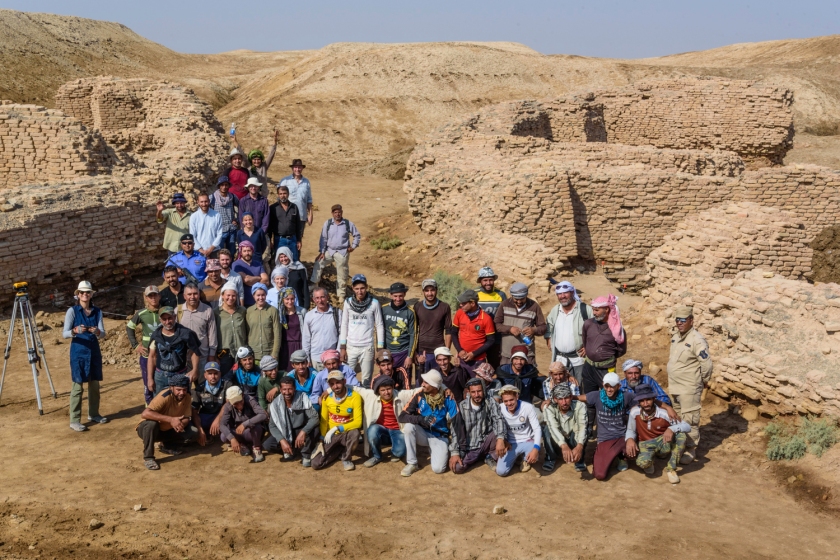
Tello-Girsu Autumn 2017 team & Iraqi participants: Sebastien Rey, Fatma Husain, Jon Taylor, Ashley Pooley, Angelo Di Michele, Joanna Skwiercz, Faith Vardy, Elisa Girotto, Ella Egberts, Dita Auzina, Dani Tagen, Andrew Ginns, Luke Jarvis, Thea Rogerson, John Darlington, Zahid Mohammad Oleiwi, Ali Kamil Khazaal, Toufeek Abd Mohammad, Qasim Rashid.
With Special Thanks to Vice Minister Dr Qais Hussein Rasheed, State Board of Antiquities and Heritage, Iraq
Contacts and website
Iraq Emergency Heritage Management Training Scheme
For more information on the Iraq Scheme, contact the Director of the Scheme, Jonathan Tubb (Head of the Middle East Department of the British Museum). Email: jtubb@britishmusuem.org
Tello-Ancient Girsu Project
For more information on the work at Tello, contact Sebastien Rey (Director of the Tello-Ancient Girsu Project). Email srey@britishmusuem.org
Iraq Scheme website
http://www.britishmuseum.org/about_us/museum_activity/middle_east/iraq_scheme.aspx
Featured image: Aerial view of the main complex of archaeological mounds of Tello (Tello-Girsu Project, Iraq Scheme, The British Museum)
 Sincerest thanks to Sebastien Rey for providing this blog post. Sebastien’s book For the Gods of Girsu: City-State Formation in Ancient Sumer (2016) is available now in paperback and eBook formats. English and Arabic editions available.
Sincerest thanks to Sebastien Rey for providing this blog post. Sebastien’s book For the Gods of Girsu: City-State Formation in Ancient Sumer (2016) is available now in paperback and eBook formats. English and Arabic editions available.

